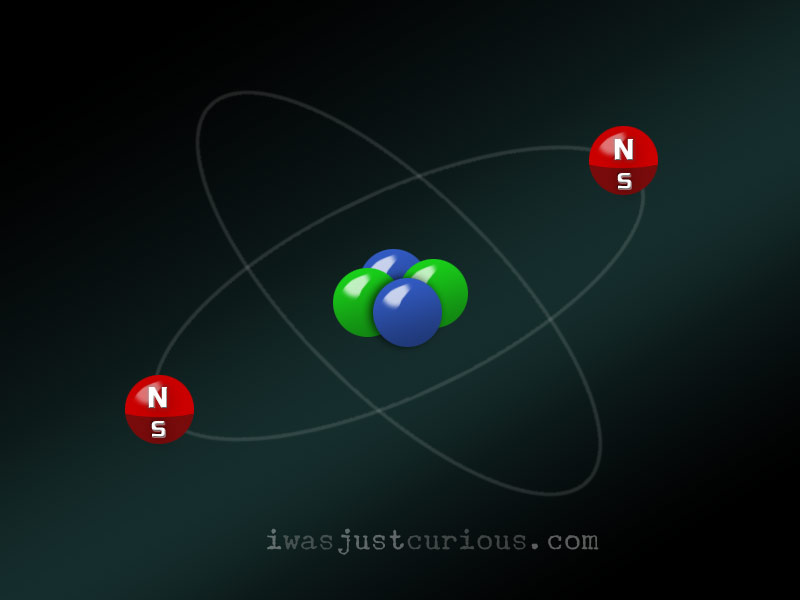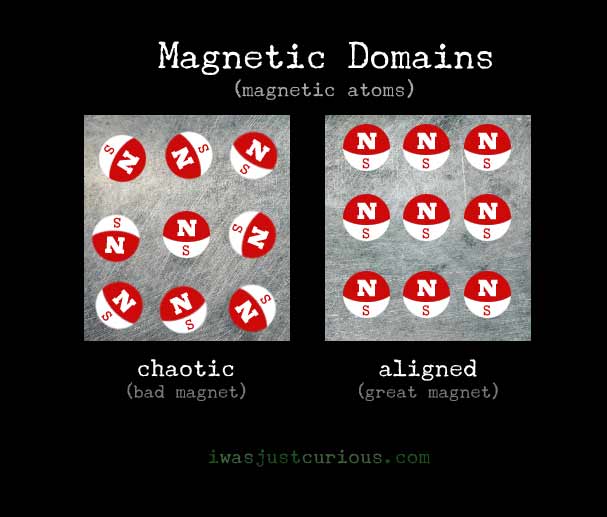Why Are Magnets Magnetic?
To get right to the point, we don't know the exact reasons. We do know at least a few things though. Let's take a look...
1) Electrons Are Magnetic

Each individual electron is a magnet with north and south poles, just like a regular magnet you'd stick on the fridge.
Why are electrons magnetic? Here's the quick, honest answer:
We don't know.
If you'd prefer a more complex, scientific sounding answer, buckle up. But be warned, we're just going to end up in the same place we started. I'd really recommend just skipping to Section 2, but if you insist, here goes:
Quantum mechanics asserts that electrons have something called a "spin." This would make perfect sense. It would mean that electrons behave like our planet, because Earth spins on an axis, has a magnetic field, and orbits around the sun. Electrons spin on an axis, have a magnetic field, and orbit around a nucleus. It's like a tiny solar system. It makes so much sense now.
Unfortunately, quantum physicists insist that electrons aren't actually spinning like the earth. Now we have to just toss out the planet analogy.
Why don't they think the electron is spinning? Because, using mathematical equations they've made, and making some assumptions about an electron—which no one has ever seen—the math doesn't seem to add up.
Apparently, if an electron were to spin, according to their calculations it would have to be spinning faster than the speed of light. Because of the Theory of Relativity, most scientists agree that you can't do that. The speed of light is apparently nature's speed limit.

So, what exactly does "spin" mean to the quantum mechanics crowd? It's not totally certain. They know it exists, but can't exactly agree on what it is. In other words, we just took the long route to the same answer: We don't know.
Remember, we didn't create science; we only discover it.
2) Atoms Can Be Magnetic Because of Electrons
Any charged particle can be magnetic. That means that both electrons and protons are magnetic. However, we don't really worry about the magnetism of protons because their magnetic force is so weak compared to the electrons. As a result, an atom's magnetism is determined by its electrons.
In an atom, there can be multiple electrons, each with their own magnetic force. However, because they aren't always "spinning" the same way, their magnetic forces are pointing different directions. The result is that their magnetic pulls cancel each other out. When many of them point the same direction, you get a strong magnetic force.
Two examples of electron configurations:
Non-Magnetic - If you have 2 electrons whose north poles are pointing up, and 2 electrons pointing down, their forces will cancel out. That atom would not be magnetic. (It would be like a car's front tires spinning forward, while the rear tires spin in reverse. They would cancel each other out.)
Magnetic - If there is 1 electron pointing up, and 2 pointing down, the material will be magnetic, because there are more pointing in one direction than the other. (The electron that's facing up will cancel out the first electron that's pointing down. That leaves one extra electron. That electron will make the atom magnetic.)
3) Materials Can Be Magnetic Because of Atoms
Now that you have some magnetic atoms, you can put them together to make a big magnet. However, the atoms must be aligned the same direction first.
Take iron, for example. If the atoms are arranged chaotically, their magnetic forces will point all over the place and you won't get a great magnet. You must first align the magnetic atoms (aka "magnetic domains") to get a powerful magnet. This can be done by putting the iron in a strong magnetic field.

A common method for aligning magnetic domains is to make an electromagnet. This can be done by wrapping a copper wire around an iron bar, and then running electricity through the wire. When the electrons move through the wire, they will create a strong magnetic force inside the iron. (Why? We don't know why, but wherever there is moving electricity, there is magnetism.) This magnetic force will stop when the electricity is turned off, but if you expose the iron to that magnetism long enough, it will eventually align the atoms and the iron will become a magnet.
Bonus Tip: The next time someone tells you "the science is settled," ask them how a magnet works.
What is Hydrogenated Oil?
A hydrogenated oil is an edible oil that has been made solid through chemical modification. This is done to increase the oil’s shelf life and make it more convenient to work with. It is often done with palm, corn, soybean, and coconut oils. Margarine uses hydrogenated vegetable oils.
How is the oil hydrogenated?
The oil is heated to extremely hot temperatures and put under high pressure. In order to create the necessary chemical reaction, a metal catalyst is added to the oil. The oil then hardens to the desired consistency.
Why should I be concerned about hydrogenated oils?
In their natural state, most oils have great health benefits. However, during hydrogenation, the oil fats are converted into artificial trans fats.
What is Canola Oil?
Canola oil is made from rapeseed. However, canola oil isn’t exactly the same as rapeseed oil. Pure rapeseed oil contains erucic acid and glucosinolates, which are both harmful to humans. As a result, the FDA banned the oil in 1956.
In the 1960s, Canadian farmers were able to breed a new form of rapeseed with lower amounts of erucic acid and glucosinolates. They called it lear oil, which stood for “low erucic acid rapeseed.” Later they changed the name to canola, which stands for “Canadian oil, low acid.” (So the acronym is a bit of a stretch, but the name is much more catchy and marketable.) The FDA eventually approved canola oil for human consumption.
Modern Canola Oil
The canola oil we use today is processed using a technique called hydrogenation, which causes Omega 9 fats to be converted to trans fats.
About 90% of canola oil in the US is genetically modified. This genetic modification makes the plant resistant to the chemical glyphosate, which is found in Roundup. As a result, farmers can spray Roundup directly onto the crops you eat.
Oil Trivia
During WWII, rapeseed oil was used as motor oil for industrial equipment.
Canola oil and rapeseed oil are both very effective at killing bugs.
How Do I Know If It's a GMO?
If I want to know what’s in my food, I check the label. I can look at my juice and see what country the fruit came from. I can find out how much phosphorous is in a handful of potato chips. I can even see if my food was made in a factory that processes nuts. Unfortunately, the label won’t tell me if my corn has been genetically modified to produce toxic proteins.
Some legislators have tried to require the labeling of GMOs, but certain companies have spent millions of dollars opposing those bills. Just for fun, here are some of the companies that have spent money trying to stop GMO labeling laws from passing.
Abbott Nutrition (Similac formula, Pedialyte)
Bimbo Bakeries USA (Sara Lee, Ball Park buns, Boboli, Cinnabon bread)
Bumble Bee Foods, LLC (tuna)
Bush Brothers & Co. (baked beans)
Campbell Soup Co.
Cargill Inc. (pink slime, supplier to McDonalds, Walmart, and many more)
The Clorox Co. (Burt's Bees)
The Coca-Cola Co. (soft drinks, Odwalla, Minute Maid, Powerade, Bacardi)
ConAgra Foods (Hunt’s, Chef Boyardee, Orville Redenbacher’s, Act II, Banquet, Kid Cuisine, Libby’s, Pam, Slim Jim, Swiss Miss, Reddi Wip, Snack Pack)
Dean Foods Co. (Meadow Gold, Land o Lakes)
Del Monte Foods Co. (fruit)
Flowers Foods, Inc. (Wonder Bread)
General Mills, Inc. (cereal, Betty Crocker, Pillsbury, Häagen-Dazs)
The Hershey Co.
The Hillshire Brands Co. (Hillshire Farms, Jimmy Dean, Ball Park)
Hormel Foods Corp. (chili, Spam, Jenny-O, Skippy)
The J.M. Smucker Co. (jams, dessert toppings, Crisco, Folgers, Dunkin Donuts coffee)
Kellogg Co. (cereal, Keebler, Pringles, Eggo waffles, Pop Tarts)
McCormick & Co., Inc (herbs and spices)
Mondelez Global, LLC. (Nabisco, Cadbury, Chips Ahoy, Oreo, Ritz)
Nestle USA, Inc. (Hot Pockets, Digiorno, Dreyer’s ice cream)
Ocean Spray Cranberries, Inc. (fruit juice)
PepsiCo, Inc. (soft drinks, Tropicana, Lays, Doritos, Quaker Oats, Gatorade, Naked Juice)
Pinnacle Foods Group, LLC (Duncan Heinz, Van de Kamp’s, Mrs. Butterworth’s)
Sunny Delight Beverages Co. (fruit drinks)
Welch Foods, Inc. (fruit juice, jam)
Is there any other way to know?
Some foods are labeled non-GMO, and other foods are labeled organic, which requires them to be non-GMO. If they aren’t specifically labeled, there are no guarantees as to what you’re eating.
The following list (courtesy of the Non-GMO Project) shows crops that have a high likelihood of being genetically modified.
Alfalfa
Canola (approx. 90% of U.S. crop is GM)
Corn (approx. 88% of U.S. crop is GM)
Cotton (approx. 90% of U.S. crop is GM)
Papaya (most of Hawaii’s crop is GM)
Soy (approx. 94% of U.S. crop is GM)
Sugar Beets (approx. 95% of U.S. crop is GM)
Zucchini and Yellow Summer Squash
What are GMOs?
GMO stands for genetically modified organism. This genetic modification is done by scientists who inject foreign genes into plant or animal DNA.
What is the purpose of genetic modification?
Genetic modification is done for a variety of reasons, including making plants resistant to bugs, herbicides, and extreme weather conditions. It has also been used to increase the nutritional content of crops.
How is it done?
As an example, let’s say you want to make a plant withstand cold weather conditions. You start by finding a plant that grows well in a cold climate. Next, you figure out which one of its genes allows it to survive the low temperatures. Finally, you implant the cold-resistant gene into another plant’s DNA.
Another example is bug-resistant crops. In order to deter bugs, the toxic protein “bacillus thuringiensis” (Bt) is added directly to a plant’s DNA.
Who does the genetic engineering?
Monsanto is the largest producer of genetically modified (GM) seeds. Monsanto is also known for producing PCBs, DDT, and Agent Orange. If you’re not familiar with those chemicals, here’s a quick rundown.
PCBs have been shown to cause cancer. They also damage the immune system, nervous system, endocrine system, and reproductive system.
DDT can cause cancer, reproductive problems, nausea, dizziness, confusion, headache, lethargy, incoordination, vomiting, fatigue, and tremors.
Agent Orange exposure can lead to numerous types of cancer and severe birth defects.
So, is it safe?
The FDA has classified GMOs as “generally recognized as safe.” As usual, I chose to look at the research myself. Here’s what I found:
Stomach Inflammation – The Institute of Health and Environmental Research conducted a study on pigs that were fed GM soy and GM corn. Female pigs that ate the GM food were 267% more likely to have severe stomach inflammation. Male pigs were 400% more likely to have inflammation when eating the GM foods.
Severe Allergic Reactions – Farmers in India exposed to GM cotton had severe allergic reactions affecting their skin, eyes, nose, and upper respiratory tract.
Tumors – A long-term study showed that rats eating GM corn developed gigantic, disgusting tumors. This study was criticized because it used sprague-dawley rats. However, many pro-GMO studies used the same type of rats. Oddly, those studies did not receive the same criticism.
(It’s interesting to note that there were studies linking smoking to cancer as far back as 1761, yet the public didn’t start to accept the mounting research until the 1950s.)
Butterflies and Bees – A study commissioned by the UK government found that in GM canola fields butterfly and bee populations were dropping drastically. Bee population was cut by ½, while butterfly population was cut by 2/3.
Liver / Kidney Toxicity – Rats that were fed GM corn had increased kidney and liver toxicity. The authors of the study concluded, “…with the present data it cannot be concluded that GM corn MON863 is a safe product.”
Fertility Problems – Rats fed GM corn had impaired fertility. A Russian study done with GM soy concluded, “…animals that eat GM foodstuffs lose their ability to reproduce.”
Digestive Problems – A study done on fish in Norway showed that GM soybeans caused gastro-intestinal problems.
Increased Appetite – This study showed that the effects of GMOs can be passed up the food chain. They started by feeding GM corn to fish. Then those fish were fed to rats. The rats had an increased appetite and grew fatter.
Bt-laced GMOs – GMOs that contain the toxin Bt have been shown to be toxic to human cells—not just the bugs they were intended to kill.
There are also numerous studies that claim GMOs are essentially the same as regular crops. Some of those studies can be found here.
GMO Bans
Several countries have either banned GMOs or severely limited their production.
Italy – Several cities across Italy, including Rome, Turin, Genoa, Milan, and Tuscany, have banned GM crops.
Austria – Austria has banned GM corn from Monsanto.
China – The Chinese military is no longer allowed to feed GMOs to troops.
France – France has banned GM corn from Monsanto.
Germany – Germany has banned has banned GM corn from Monsanto.
Luxembourg – Luxebourg has banned Bt corn made by Novartis.
Portugal – Portugal has banned Bt corn made by Novartis.
Greece – Greece has banned GM corn from Monsanto and GM potatoes from BASF.
Hungary – Hungary has banned GM corn from Monsanto.
Poland – Poland has banned GM corn from Monsanto, and has a ban on sales of any GM seeds.
Romania – Romania has banned GM corn from Monsanto.
UK – The Church of England refuses to allow GM crops on its land. The House of Commons won’t allow GM crops to be used in its catering.
Norway – Norway has banned GM crops containing antibiotic resistant genes.
Australia – Several locations across Australia have declared themselves to be GMO-free
New Zealand – Some areas of New Zealand are GMO-free.
Thailand – Thailand has banned over 40 GM crops.
Saudi Arabia – Saudi Arabia has banned growing GMOs and importing GM wheat.
Egypt – Egypt has banned all GM wheat imports.
Algeria – Algeria has an outright ban on all GMOs, except for research purposes.
Brazil – Brazil has banned the planting of GM seeds.
Japan – Japan has various GMO bans.
Bulgaria – Bulgaria has a ban on all GMOs.
Russia - Russia has a ban on all GMOs.
USA – Many attempts have been made to ban GM crops, but they have mostly been shot down by legislators.
The countries and crops on this list will continue to grow as time goes on.
Avoiding GMOs
If you’d like to steer clear of GMOs, you may want to check out the list of common GMOs.
Sources:
http://www.monsanto.com/newsviews/pages/food-safety.aspx - purpose of GMOs
http://www.bt.ucsd.edu/bt_crop.html - pesticide toxin added to crops
http://www.atsdr.cdc.gov/toxprofiles/tp17-c5.pdf - Monsanto produced 99% of PCBs
http://www.epa.gov/epawaste/hazard/tsd/pcbs/pubs/effects.htm - Negative effects of PCBs
http://npic.orst.edu/factsheets/ddtgen.pdf - Negative effects of DDT
http://www.publichealth.va.gov/exposures/agentorange/conditions/index.asp - Negative effects of Agent Orange
http://gmojudycarman.org/new-study-shows-that-animals-are-seriously-harmed-by-gm-feed/ - GM pig feed; stomach inflammation
http://www.biosafety-info.net/article.php?aid=352 – GM cotton caused severe allergic reactions
http://www.ncbi.nlm.nih.gov/pubmed/22999595 - GM corn caused massive, disgusting tumors
http://www.ask-force.org/web/HerbizideTol/Williams-Safety-Evaluation-Risk-Assessment-RR-2000.pdf - pro-GMO study used Sprague-Dawley rats
http://tobacco.harpweek.com/hubpages/CommentaryPage.asp?Commentary=Cancer – tobacco/cancer link researched in 1761 by Dr. John Hill
http://rspb.royalsocietypublishing.org/content/272/1562/463.full.pdf - butterflies and bees
http://www.ncbi.nlm.nih.gov/pubmed/17356802 - gm corn caused increased liver/kidney toxicity
http://www.biosicherheit.de/pdf/aktuell/zentek_studie_2008.pdf - GM corn caused reproductive problems
http://voiceofrussia.com/2010/04/16/6524765.html/ - Rats couldn’t reproduce.
http://www.gmwatch.eu/gm-videosb/28-gm-food-safety/14120 - digestive issues from gm soy; gm corn caused animals to eat more
http://www.gmfreecymru.org/pivotal_papers/crucial27.htm - Bt toxic to humans
http://gaiapresse.ca/images/nouvelles/28563.pdf - Most GM studies done by biotech companies
http://www.organicconsumers.org/gefood/countrieswithbans.cfm - GMO bans
http://www.gmo-free-regions.org - GMO bans
http://ecowatch.com/2014/05/15/chinese-army-gmo/ - Chinese Army eats non-gmo
http://www.thenation.com/blog/176863/twenty-six-countries-ban-gmos-why-wont-us - gmo bans
⬅ Previous Posts
